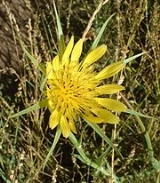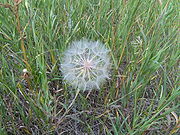
Western Salsify
Encyclopedia
Tragopogon dubius is a species of Salsify
native to southern
and central Europe
and western Asia and found as far north and west as northern France. Although it has been reported from Kashmir
and India
, recent evidence suggests that specimens from these areas may be a different species. Western Salsify has been introduced
into North America
where it has become widespread, being reported from all the continental United States
except for a few in the far south-east, and all provinces of Canada except Newfoundland and the northern territories.
Like most salsifies, the Western Salsify grows as an annual
or occasionally biennial
forb
, reaching a height of typically 20-60 cm but sometimes almost a metre. It grows typically in warm, sheltered spots with moist soil. Its yellow flower is 4-6 cm in diameter and is likely to be seen in late spring or early summer. The flowers open early in the morning and often close up by late afternoon. Later the plant forms a seed head that resembles that of the dandelions but is distinctly larger. The seeds themselves (known as achene
s) are 2-4 cm long but featherweight, weighing about 8 mg each on average. There is some natural variation between the central and peripheral achenes in the seedhead, with the peripheral ones being generally darker and heavier, and having a higher concentration of phenol
ic compounds; this may enhance their survival potential.
Western Salsify is quite similar to the generally commoner Meadow Salsify
, T. pratensis, but the bract
s which show behind the flower, a distinctive feature of salsifies, are longer and more noticeable. Although not particularly closely related to Meadow Salsify or the Common Salsify or Oyster Plant (T. porrifolius), the Western Salsify hybridises readily with both, and in North America its hybrids have given rise to the new alloploid hybrid species T. mirus and T. miscellus.
Because Western Salsify is a widespread plant, it has a large number of alternative common names. They include Western Goat's Beard, Wild Oysterplant, Yellow Salsify, Yellow Goat's Beard, Meadow Goat's Beard, Goat's Beard, Goatsbeard, Common Salsify, or Salsify. Some of these are also, or more commonly, used for other species, and are better avoided. A synonym, Tragopogon major, may also be encountered.
Unlike some other species of salsify such as the Oyster Plant
Tragopogon porrifolius, Western Salsify is not generally regarded as edible, though the root can be eaten (raw or cooked) and so can the young stems. No uses in herbal medicine are commonly known. It is regarded as invasive
in most states of the USA and in some Canadian
provinces such as Ontario
and British Columbia
.

Salsify
Tragopogon, also known as salsify or goatsbeard, is a genus of flowering plants in the sunflower family Asteraceae that has over 140 species, including the vegetable known as salsify, as well as a number of common wild flowers, some of which are usually regarded as weeds.Salsifies are forbs growing...
native to southern
Southern Europe
The term Southern Europe, at its most general definition, is used to mean "all countries in the south of Europe". However, the concept, at different times, has had different meanings, providing additional political, linguistic and cultural context to the definition in addition to the typical...
and central Europe
Central Europe
Central Europe or alternatively Middle Europe is a region of the European continent lying between the variously defined areas of Eastern and Western Europe...
and western Asia and found as far north and west as northern France. Although it has been reported from Kashmir
Kashmir
Kashmir is the northwestern region of the Indian subcontinent. Until the mid-19th century, the term Kashmir geographically denoted only the valley between the Great Himalayas and the Pir Panjal mountain range...
and India
India
India , officially the Republic of India , is a country in South Asia. It is the seventh-largest country by geographical area, the second-most populous country with over 1.2 billion people, and the most populous democracy in the world...
, recent evidence suggests that specimens from these areas may be a different species. Western Salsify has been introduced
Introduced species
An introduced species — or neozoon, alien, exotic, non-indigenous, or non-native species, or simply an introduction, is a species living outside its indigenous or native distributional range, and has arrived in an ecosystem or plant community by human activity, either deliberate or accidental...
into North America
North America
North America is a continent wholly within the Northern Hemisphere and almost wholly within the Western Hemisphere. It is also considered a northern subcontinent of the Americas...
where it has become widespread, being reported from all the continental United States
United States
The United States of America is a federal constitutional republic comprising fifty states and a federal district...
except for a few in the far south-east, and all provinces of Canada except Newfoundland and the northern territories.
Like most salsifies, the Western Salsify grows as an annual
Annual plant
An annual plant is a plant that usually germinates, flowers, and dies in a year or season. True annuals will only live longer than a year if they are prevented from setting seed...
or occasionally biennial
Biennial plant
A biennial plant is a flowering plant that takes two years to complete its biological lifecycle. In the first year the plant grows leaves, stems, and roots , then it enters a period of dormancy over the colder months. Usually the stem remains very short and the leaves are low to the ground, forming...
forb
Forb
A forb is a herbaceous flowering plant that is not a graminoid . The term is used in biology and in vegetation ecology, especially in relation to grasslands and understory.-Etymology:...
, reaching a height of typically 20-60 cm but sometimes almost a metre. It grows typically in warm, sheltered spots with moist soil. Its yellow flower is 4-6 cm in diameter and is likely to be seen in late spring or early summer. The flowers open early in the morning and often close up by late afternoon. Later the plant forms a seed head that resembles that of the dandelions but is distinctly larger. The seeds themselves (known as achene
Achene
An achene is a type of simple dry fruit produced by many species of flowering plants. Achenes are monocarpellate and indehiscent...
s) are 2-4 cm long but featherweight, weighing about 8 mg each on average. There is some natural variation between the central and peripheral achenes in the seedhead, with the peripheral ones being generally darker and heavier, and having a higher concentration of phenol
Phenol
Phenol, also known as carbolic acid, phenic acid, is an organic compound with the chemical formula C6H5OH. It is a white crystalline solid. The molecule consists of a phenyl , bonded to a hydroxyl group. It is produced on a large scale as a precursor to many materials and useful compounds...
ic compounds; this may enhance their survival potential.
Western Salsify is quite similar to the generally commoner Meadow Salsify
Meadow Salsify
Meadow Salsify Tragopogon pratensis is a biannual plant in the Asteraceae family, distributed across Europe and North America, commonly growing in fields and on roadsides...
, T. pratensis, but the bract
Bract
In botany, a bract is a modified or specialized leaf, especially one associated with a reproductive structure such as a flower, inflorescence axis, or cone scale. Bracts are often different from foliage leaves. They may be smaller, larger, or of a different color, shape, or texture...
s which show behind the flower, a distinctive feature of salsifies, are longer and more noticeable. Although not particularly closely related to Meadow Salsify or the Common Salsify or Oyster Plant (T. porrifolius), the Western Salsify hybridises readily with both, and in North America its hybrids have given rise to the new alloploid hybrid species T. mirus and T. miscellus.
Because Western Salsify is a widespread plant, it has a large number of alternative common names. They include Western Goat's Beard, Wild Oysterplant, Yellow Salsify, Yellow Goat's Beard, Meadow Goat's Beard, Goat's Beard, Goatsbeard, Common Salsify, or Salsify. Some of these are also, or more commonly, used for other species, and are better avoided. A synonym, Tragopogon major, may also be encountered.
Unlike some other species of salsify such as the Oyster Plant
Oyster Plant
Oyster Plant is a common name used for various flowering plants, including:*Tragopogon porrifolius *Mertensia maritima*Tradescantia discolor Synonyms: Tradescantia spathacea, Rhoeo spathacea, Rhoeo discolor....
Tragopogon porrifolius, Western Salsify is not generally regarded as edible, though the root can be eaten (raw or cooked) and so can the young stems. No uses in herbal medicine are commonly known. It is regarded as invasive
Invasive species
"Invasive species", or invasive exotics, is a nomenclature term and categorization phrase used for flora and fauna, and for specific restoration-preservation processes in native habitats, with several definitions....
in most states of the USA and in some Canadian
Canada
Canada is a North American country consisting of ten provinces and three territories. Located in the northern part of the continent, it extends from the Atlantic Ocean in the east to the Pacific Ocean in the west, and northward into the Arctic Ocean...
provinces such as Ontario
Ontario
Ontario is a province of Canada, located in east-central Canada. It is Canada's most populous province and second largest in total area. It is home to the nation's most populous city, Toronto, and the nation's capital, Ottawa....
and British Columbia
British Columbia
British Columbia is the westernmost of Canada's provinces and is known for its natural beauty, as reflected in its Latin motto, Splendor sine occasu . Its name was chosen by Queen Victoria in 1858...
.

External links
- USDA PLANTS database profile for the species
- Jepson Manual treatment of the species
- http://calphotos.berkeley.edu/cgi/img_query?query_src=photos_index&where-lifeform=any&rel-taxon=contains&where-taxon=tragopogon+dubius&rel-namesoup=matchphrase&where-namesoup=&rel-location=matchphrase&where-location=&rel-state=eq&where-state=any&rel-country=eq&where-country=any&where-collectn=any&rel-photographer=eq&where-photographer=any&rel-kwid=equals&where-kwid=Pictures from the CalPhotos archive]
- Plants for a Future database entry for the species

